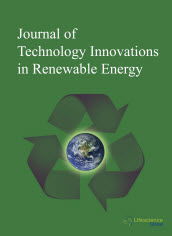jtire
|
|
|
Abstract: Multicrystalline (multi-Si) photovoltaic (PV) technology is increasingly common throughout Australia and the developed world, as renewable energy technologies become viable electrical generation alternatives to coal and nuclear power. We have examined the cradle-to-grave life cycle of a 3kWp multi-Si PV system within Australia. The highest contribution of environmental impacts results from the usage of fossil fuel energy resources and their emissions at the pre-production and manufacturing stages. We analyze the impacts of multi-Si technology on ecosystem goods and services (EGS) and compared it with impacts resulting from coal power electricity. For 3kWp multi-Si system, coal, crude oil and iron ore were the critical resources consumed from the lithosphere while the public supply of water was consumed from the hydrosphere. For coal power electricity, coal and water were the resources most consumed from both the lithosphere and hydrosphere. However the resource consumption from coal power electricity is significantly larger than that of multi-Si PV. Coal power electricity is also responsible for much greater energy and exergy consumption compared to multi-Si PV. The main ecosystem disturbances resulting from the lifecycle of a 3kWp multi-Si unit affect supporting and regulating services though these disturbances are considerably lower than the services impacted from coal power electricity. The study concludes that similar analysis performed on another PV technology would provide a greater understanding to the Eco-LCA results for multi-Si PV technology, particularly with relation to exergy analysis. Keywords: Eco-LCA, multi-Si PV, ecosystem goods services, solar, exergy, coal.Download Full Article |
|
|
|
Abstract: The energy security issue has been paid close attention by many countries owing to the rising energy demand, the limited energy reserve, and the climate change problem. In spite of the broad concern, there is no globally accepted definition of energy security because, for any country, the impact of energy insecurity is highly correlated with its economic status, its resource endowment, its geopolitical partnership, as well as many other nation-specific features. Therefore, by using some of the world's largest energy consuming nations as examples, this article reviews the definitions of energy security and discusses the strategies to enhance it, in order to provide insight for policy makers from different countries. The results find that major energy consuming countries take measures to improve energy security status primarily by improving energy self-sufficiency and increasing energy diversification. Besides, this study also provides suggestion for different countries to take part in international energy cooperation in order to achieve a Pareto improvement of their energy security statuses. Keywords: Energy security, energy consuming country, international energy cooperation. Download Full Article |
|
|
|
Abstract: Energy saving is a significant feature to take in account in the choice of renewable energy technologies to use. This paper techno-economically investigates an excess heat recovery system that is proposed to be installed in a thermal cure center geothermal source for producing domestic hot water to be conveyed through piping to a nearby three star hotel located in Antsirabe Madagascar. For that purpose, the hotel hot water needs were determined by using an available online free code, called Solo, and the effectiveness-NTU method was used to size the plate heat exchanger to be used to recover the geothermal heat. The proposed hybrid geothermal solution performance was compared with that of hybrid solar energy water-heaters in terms of electricity consumption related to water temperature adjustment. It follows from comparison results that the proposed hybrid geothermal solution is more profitable and allows about 73.2 (%) of electric energy saving while it is 54.9 (%) for hybrid solar option. Besides, economic evaluation confirmed that the geothermal installation allows a shorter return on investment more favorably. Keywords: Heat recovery system, geothermal energy, heat exchanger, energy savings, domestic hot water production.Download Full Article |
|
|
|
Abstract: Iron-doped TiO2 nanopowders with different doping amounts have been prepared by co-precipitation method followed by heat treatment. The obtained materials were structurally, morphologically and analytically characterized by X-ray diffraction (XRD), FT-Raman spectroscopy, diffuse reflectance spectroscopy (DRS) and energy dispersive X-ray spectroscopy (EDX) coupled to scanning electron microscopy (SEM). XRD analysis revealed the major presence of the anatasa crystalline phase for iron-doped and undoped TiO2. SEM confirmed particles sizes among the nanometer scale along with XRD data. The presence of iron ions was validated by EDX-SEM. Diffuse reflectance techniques were carried out to validate the shift of the band edge absorption spectrum of doped TiO2 nanoparticles towards the visible region and to confirm the presence of iron atoms in the TiO2 crystal lattice by the resulting variation of the band gap value of the doped materials. Photocatalytic activity of the nanoparticles under UV and visible radiation was evaluated by means of hydroxyl radicals production through indirect estimation using N,N-dimethyl-p-nitrosoaniline (PNDA)photo-discoloration experiments in aqueous dispersion. Samples containing 1.2 and 5.6 weight % Fe exhibited the highest activities in this study for both conditions.. Keywords: Doped titanium dioxide, anatase, photocatalytic degradation, iron doping.Download Full Article |
|
|
|
Abstract: To examine the solvent isotope effect on hydrogen-transfer reduction of CO2 into formate with glycerine by alkaline hydrothermal reaction, intermediates were identified by 13C-NMR, 1H-NMR, 2H-NMR, LC-MS analyses. The results showed that (1) CO2 was indeed converted into abiogenic formate; (2) a ketone carbonyl group as intermediate product was formed on hydrogen-transfer reduction of CO2 into formate with glycerine by alkaline hydrothermal reaction; (3) acetol was the most probable intermediate in the first reaction by undergoing a dehydration rather than a dehydrogenation. Keywords: CO2, glycerine, solvent isotope effect, alkaline hydrothermal reaction.Download Full Article |



